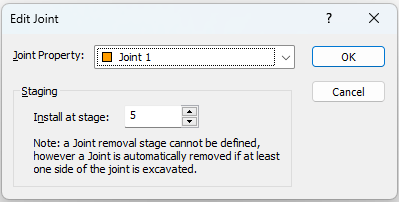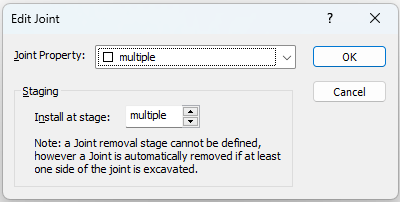Edit Joint
The Edit Joint option allows you to view and modify the installed joint(s). Both properties and staging can be edited. To be mentioned, the end condition of the joint(s) can be edited with the Edit Joint/Structural End Condition option from the Boundaries menu, details are described below.
To edit joints,
- Make sure one or more joint(s) are created in the model with the Add Joint
 option.
option. - Select the Edit Joint option from the Boundaries menu (proceed to Step 2), or right click to select a joint in the model, and select the Edit Joint option from the popup menu (proceed to Step 3).
- You will first be prompted to pick the joint(s). Use the mouse to select the joint(s) you would like to edit. You can drag select multiple joints. Hit Enter key, or right click and select Done Selection.
- The Edit Joint dialog will show as below. You can view and modify the information in the dialog.

Joint Property – the joint property determines the slip criterion, stiffness, and other parameters. More details can be found in Define Joints help topic.
Staging - if your model is staged, you can specify the installation stage of the joint(s). Note that a joint removal stage cannot be defined. However, a joint is automatically removed if the material on either (or both) sides of the joint is excavated. See details in the Add Joint – Joints and Staging section.
Install at stage - by default, the installation stage will be set to the stage that you are currently viewing (i.e. the currently selected stage tab). You can enter a different stage if necessary.
Edit Multiple Joints
You can simultaneously select and edit multiple joints with the Edit Joint option.
When multiple joints are selected and they have different properties or installation settings, the value of correspondent field in the Edit Joint
dialog will be display as “multiple” (as shown below). In this case, if you edit the joint parameters and select OK in the dialog, these parameters will be applied to all selected joints. Therefore, if you wish to edit multiple joints and apply different properties or installation settings to each, the joints must be edited individually.

Edit End Condition
Rather than the Edit Joint option, the end condition of joint(s) can be edited with the Edit Joint/Structural End Condition option from the Boundaries menu. This option can be used for both joint and structural interface supports. See the Edit Joint/Structural End Condition topic for details.
For details about defining the End Condition of a joint, see the Add Joint topic.